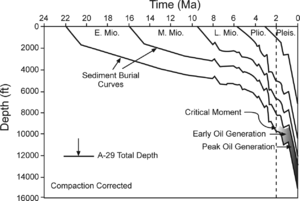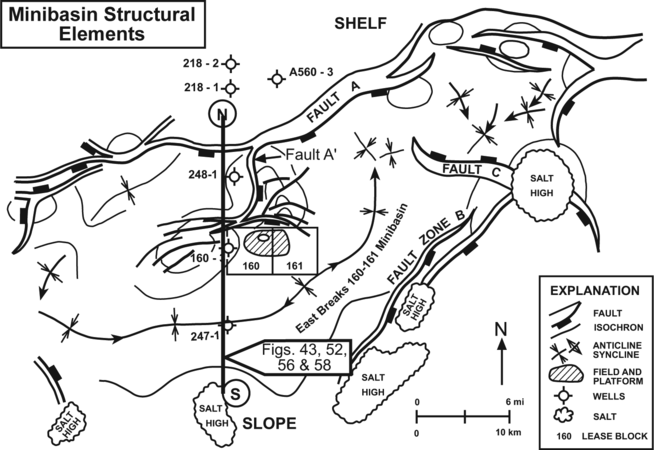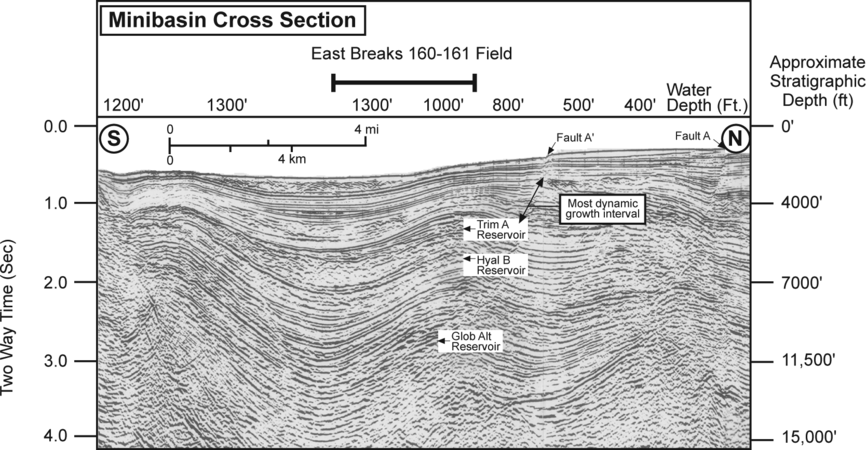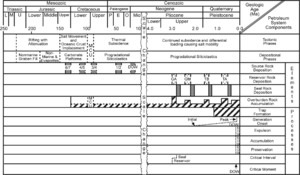East Breaks critical moment
| Exploring for Oil and Gas Traps | |

| |
| Series | Treatise in Petroleum Geology |
|---|---|
| Part | Critical elements of the petroleum system |
| Chapter | Sedimentary basin analysis |
| Author | John M. Armentrout |
| Link | Web page |
| Store | AAPG Store |
Magoon and Dow[1] define the critical moment as the time that best depicts the generation-migration-accumulation of most hydrocarbons in a petroleum system. The East Breaks 160-161 field began to accumulate no earlier than 1.2 Ma when the trap began forming, and accumulation is inferred to continue to the present[2] The structural configuration has changed little since initial formation, so that the present-day map (Figure 1) and cross-sectional geometry (Figure 2) accurately depict the trapping aspects of the petroleum system.
Figure 1 Map of structural elements that define the East Breaks 160-161 minibasin, which is bound on the north by fault A, on the east by faults B and C, and on the south by a salt-cored high. Copyright of: Armentrout et al.;[3] courtesy Springer-Verlag.
Possible critical moments

According to the maturation model for a middle Miocene source rock, peak oil generation would have begun 0.2 Ma[2] and the critical moment for the East Breaks 160-161 petroleum system would be 0.20 Ma (Figures 3 and 4). If a stratigraphically deeper lower Paleocene or upper Jurassic source rock is the origin of the East Breaks oils, an earlier onset of significant generation could have occurred with migration, continuing to today and supplying the petroleum that has charged the field.
Summary
The critical moment will be different for the middle Miocene, lower Paleocene, and lower Tertiary source rock. The critical interval encompasses the composite of all critical moments. The critical interval for the East Breaks 160-161 petroleum system is 2.8 Ma to the present. It is that time period after deposition of the reservoir and seal during which subsequent growth fault movement formed the anticlinal trap and accumulation of migrating hydrocarbons occurred.
See also
- East Breaks petroleum system
- East Breaks trap formation
- East Breaks geochemistry
- East Breaks hydrocarbon generation model
- East Breaks hydrocarbon migration model
- East Breaks hydrocarbon accumulation model
References
- ↑ Magoon, L. B., and W. G. Dow, 1994, The Petroleum System--From Source to Trap: AAPG Memoir 60, p. 3–24.
- ↑ 2.0 2.1 2.2 2.3 Dow, W. G., M. A. Yukler, J. T. Senftle, M. C. Kennicutt, and J. M. Armentrout, 1990, Miocene oil source beds in the East Breaks basin, Flex-Trend, offshore Texas: Proceedings, Gulf Coast Section SEPM 9th Annual Research conference, p. 139–150.
- ↑ Armentrout, J. M., S. J. Malacek, P. Braithwaite, and C. R. Beeman, 1991, Seismic facies of slope basin turbidite reservoirs, East Breaks 160-161 field: Pliocene–Pleistocene, northwest- ern Gulf of Mexico, in P. Weimer and M. J. Link, eds., Seismic Facies and Sedimentary Processes of Submarine Fans and Turbidite Systems: New York, Springer-Verlag, p. 223–239.
- ↑ Haq, B., J. Hardenbol, and P. R. Vail, 1988, Mesozoic and Cenozoic chronostratigraphy and cycles of sea-level change: SEPM Special Publication 42, p. 71–108.


